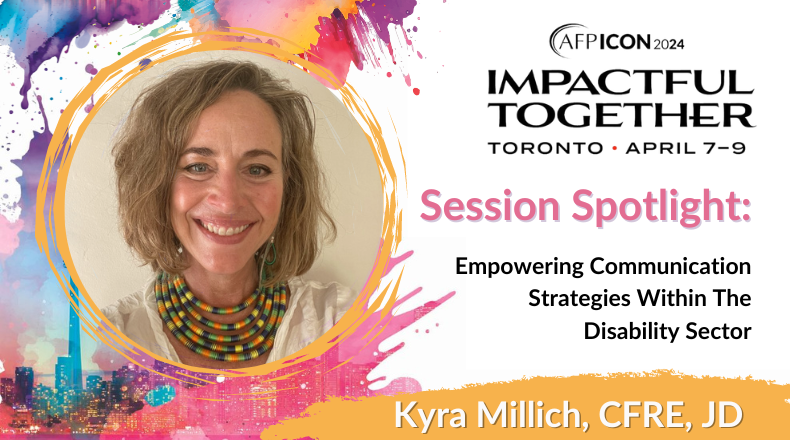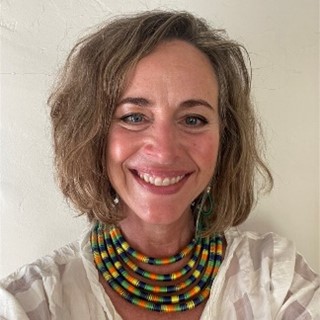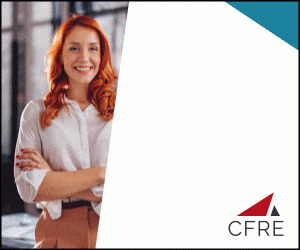Fundraising Within the Disability Community

If your nonprofit organization fundraises within the disability community, you might be wondering how to best connect with a person living with a chronic disabling condition. Chances are that you interact in your personal or professional life somewhat regularly with the disability community. How comfortable are you with that interaction?
According to the World Report on Disability, one billion people live with some form of disability, making up around 15% of the global population. The Americans with Disabilities Act defines a person with a disability as someone who:
- has a physical or mental impairment that substantially limits one or more major life activities,
- has a history or record of such an impairment (such as cancer that is in remission), or
- is perceived by others as having such an impairment (such as a person who has scars from a severe burn).
As a fundraiser, your job is to understand the perspective of potential donors with the end goal of becoming partners and allies in improving the world. You do this by listening and asking open-ended questions – at the right place and at the right time. This may appear as a particularly nuanced task when interacting with someone who has a disability.
When I was diagnosed in 2013 with multiple sclerosis, the left side of my body would not function. I was unsure if mobility would return completely or partially, and whether my MS would continue to progress physically and cognitively. Today, I am fortunate to be ambulatory – with some limitations – but have a number of limiting invisible disabilities. And the possibility of MS progression continues to loom. My personal awareness of disability has been amplified and broadened by the hundreds of people I’ve worked with at the National MS Society. Although by no means exhaustive, this article suggests just a few guidelines that I have learned to communicate in a manner that leaves all parties feeling understood, inspired, and empowered.
Using Curiosity to Overcome Unconscious Bias
The first step is to recognize the possibility that your approach might be wrong. If you are a philanthropic professional that prioritizes inclusion and strives toward egalitarianism, you may think you are objectively taking in information. But, the scientific truth is, a majority of how you process information occurs outside of your conscious awareness or control, aka “unconscious bias.”
Humans have a natural tendency to sort people into groups based on characteristics such as disability, gender, age, race, ethnicity, sexual orientation, and religion. It’s how you move through the world — these unconscious responses allow your brain to process vast amounts of information about people you encounter at lightning speed. However, the resulting judgements, decisions, and actions toward demographic groups result in unequal outcomes. For example:
- Do you feel a connection to those you perceive as similar to you?
- Do you have stereotypes or assumptions about specific groups?
- Do you project positive qualities onto people without knowing them?
- Do you look for proof to confirm your own opinions and pre-existing ideas about someone?
How to Move Through Unconscious Bias
The good news is that your brain, and your unconscious biases, are malleable. Once you acknowledge their existence, you can take steps – led by curiosity – to minimize how often they are activated and to reduce their effect on your actions. You’ll find that curiosity is a powerful communication tool that will increase awareness and improve relationships.
Suggested Actions
- Get to know a person one-on-one. Focus on their individual interests, characteristics, and preferences rather than stereotypes. When you meet someone, activate your strong desire to know the person - by learning about the person first – rather than seeing their disability first. Every person has a host of experiences and interests in addition to their disability. What change is longing to happen in the world for them, and how might your organization fulfill that vision?
- Rather than focus on perceived differences and assumptions, focus on what you have in common. For instance, when you meet someone who is in a wheelchair, do you see their wheelchair before the person? Do you think a person must be unhappy because they are disabled in some way? Do you believe a person that slurs or has cerebral palsy must be cognitively compromised? Do you think a disabled person is less likely to donate money to a cause they believe in?
- Curiosity, rather than silence, overcomes discomfort for all parties. If you aren’t sure how to engage, ask the person. Would the person in a wheelchair prefer that you sit in a chair rather than standing while you are talking? Chances are they’ll appreciate the offer not to crane their neck up.
- Do your research to counter your stereotypes about disabled people. Focus on what they can do instead of what they cannot do. For example, a blind person may experience much more than you ever knew possible without sight.
- Consider the perspective of the individual regarding how they feel about adaptive techniques they utilize in order to function successfully. Does society provide accommodations to meet those adaptations? Do you wear headsets for zoom calls to accommodate the hearing impaired? Does your gala have entrances and bathrooms that accommodate someone using adaptable equipment? Is there a quiet place for someone to retreat to if there are flashing lights that might trigger a reaction?
- Consider a person’s perspective in an encounter where someone raises their voice, or keeps their distance, or speaks to their more able-bodied-in-appearance companion instead of them. How would you feel?
- Rather than speak for the person, ask for their input. And determine how they’d like to be identified. Does that person prefer to be identified as: a) a person living with a disability; b) a disabled person; or c) a person? Ask them. Opinions differ.
- As a colleague, call others out in a respectful manner, rather than say nothing. Engage in curiosity and specifics, i.e. ‘why do you assume he won’t be able to do that?’ Brainstorm about actions that can be taken to be more inclusive or understanding rather than assuming there is nothing that can be done because ‘that’s just the way it is’.
- Engage in training about implicit biases, stigmas, and disability ableism. Consider the ways in which we have been programmed to see disability as something bad, or which makes us uncomfortable, or as something that needs to be ‘fixed’ in order for that person to live a full and engaging life (Darth Vader, Captain Hook, and Tiny Tim come to mind).
- When you fail, fail forward, and learn from others. Apologize if you need to instead of staying silent and perpetuating discriminatory beliefs and practices.
- And do all of this again and again and again.
Conclusion
It is up to you to build a bridge and new mental associations at every opportunity in which you meet a potential donor living with a disability. Without a doubt, your curiosity has the power to improve relationships and fortify your fundraising skills to connect toward a common goal.
You can learn more about this topic by attending Kyra’s session, Empowering Communication Strategies in the Disability Sector, at AFP ICON, April 7-9, 2024 in Toronto, Canada.
 Kyra Millich is the Major Gifts Officer for the Western Region of the United States and co-founder of the Disability Employment Resource Group at the National Multiple Sclerosis Society. After receiving a diagnosis of MS, Kyra transitioned from consumer protection litigation to development - first managing peer-to-peer fundraising events - and then as an individual giving professional. She is honored to specialize in genuine empowerment, inspiration and enrollment of persons impacted by disability. She can be reached at kyra.millich@nmss.org.
Kyra Millich is the Major Gifts Officer for the Western Region of the United States and co-founder of the Disability Employment Resource Group at the National Multiple Sclerosis Society. After receiving a diagnosis of MS, Kyra transitioned from consumer protection litigation to development - first managing peer-to-peer fundraising events - and then as an individual giving professional. She is honored to specialize in genuine empowerment, inspiration and enrollment of persons impacted by disability. She can be reached at kyra.millich@nmss.org.




